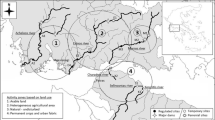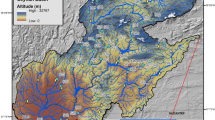Abstract
A survey was carried out at 156 sites, situated in streams in the province of Overijssel (The Netherlands), to describe the macroinvertebrate assemblages and their environments. Fifty-six environmental variables were measured once at each sampling site. The main aim was to describe a typology of stream for this region.
Different multivariate analysis techniques (clustering and ordination) were used in combination with ecological information on individual taxa to derive and describe site groups in terms of taxonomic composition and mean environmental conditions. The resulting site groups were termed cenotypes.
Eleven cenotypes were distinguished. Differences between cenotypes were attributed to (combinations of) environmental key factors, namely, dimensions (width and depth), morphological (profile shape) and hydraulic stream characteristics, duration of drought and load of organic material.
The typology offers a basis to be used for regional stream management and nature conservation. Efforts to improve stream ecosystems should be directed at the physical and hydraulic conditions.
Typological studies are needed (especially in semi-natural landscapes) if we are to better understand, manage and conserve freshwater biota.
Similar content being viewed by others
References
Berg, K., 1948. Biological studies on the river Susaa. Folia limnol. scan. 4: 1–318.
Bernhardt, K., 1985. Das Vorkommen, die Verbreitung, die Standortansprüche und Gefährdung der Vertreter der Div. Hydrocoriomorpha und Amphibicoriomorpha Stichel, 1955 (Heteroptera) in der Westfälischen Bucht und angrezenden Gebieten. Abhandlungen Westfalischen Museum für Naturkunde 47: 3–30.
Boesch, D. F., 1977. Application of numerical classification in ecological investigations of water pollution. Spec. Sc. Rep. 77, Virginia Institute for Marine Sciences.
Brindle, A., 1967. The larvae and pupae of the British Cylindrotominae and Limoniinae (Diptera, Tipulidae). Trans. Soc. Brit. Ent. 17: 151–216.
Brinkhurst, R. O., 1964. Observations on the biology of lake dwelling Tubificidae. Arch. Hydrobiol. 60: 385–418.
Brinkhurst, R. O. & B. G. M. Jamieson, 1971. Aquatic Oligochaeta of the world. Oliver and Boyd, Edinburgh.
Chekanovskaja, O. V., 1962. The aquatic oligochaete fauna of the U.S.S.R. Opredeliteli po Faune SSSR 78: 1–411. (in Russian).
Cooling, D. A., 1981. Records of aquatic Coeoptera from rivers in southern England. Entomologist's Gazette 32: 103–113.
Cranston, P. S., D. R. Oliver & O. A. Saether, 1983. The larvae of Orthocladiinae (Diptera: Chironomidae) of the Holarttic region — Key and diagnoses. Ent. Scand., Suppl. 19: 149–291.
Cummins, K. W., 1973. Trophic relations of aquatic insects. Ann. Rev. Ent. 18: 183–205.
Den Hartog, C., & L. De Wolf, 1962. The life cycle of the water snail Aplexa hypnorum. Basteria, 26: 61–72.
Edington, J. M. & A. G. Hildrew, 1981. Caseless caddis larvae of the British Isles. Freshwat. Biol. Ass., Sc. Publ. 43: 1–91.
Elliott, J. M., 1977. A key to British Megaloptera and Neuroptera. Freshwat. Biol. Ass., Sc. Publ. 35: 1–52.
Elliott, J. M. & K. H. Mann, 1979. A key to the British freshwater leeches. Freshwat. Biol. Ass., Sc. Publ. 40: 1–72.
Ellis, A. E., 1978. British freshwater bivalve mollusca. Synopsis of the British Fauna (N.S.) 11: 1–109. Academic Press, London.
Fittkau, E. J. & S. S. Roback, 1983. The larvae of Tanypodinae (Diptera: Chironomidae) of the Holarctic region — Key and diagnoses. Ent. Scand., Suppl. 19: 33–110.
Freude, H., K. W. Harde & G. A. Lohse, 1971. Die Käfer Mitteleuropas. Band 3. Goecke und Evers, Krefeld.
Furse, M. T., D. Moss, J. F. Wright & P. D. Armitage, 1984. The influence of seasonal and taxonomic factors on the ordination and classification of running-water sites in Great Britain and on the prediction of their macro-invertebrate communities. Freshwat. Biol. 14: 257–280.
Gardeniers, J. J. P. & H. H. Tolkamp, 1985. The effect of stream regulation on the macroinvertebrate communities of Dutch lowland streams. Paper presented at the 3th International Symposium of Regulated Streams, Edmonton.
Garms, R., 1961. Biozönotische Untersuchungen an Entwässerungsgräben in Flussmarschen des Elbe-Aestuars. Arch. Hydrobiol., Suppl. 26: 344–462.
Gauch, H. G. Jr., 1977. ORDIFLEX — A flexible computer program for four ordination techniques: weighted averages, polar ordination, principal component analysis, and reciprocal averaging. Ecology and Systematics, Cornell University, Ithaca.
Hawkes, H. A., 1975. River zonation and classification. Pages 312–374 in B. A. Whitton (editor). River ecology. Studies in ecology 2, University California Press.
Hickin, N. E., 1967. Caddis larvae. Hutchinsons, London.
Higler, L. W. G., 1975. Reactions of some caddis larvae (Trichoptera) to different types of substrate in an experimental stream. Freshwat. Biol. 5: 151–158.
Higler, L. W. G. & A. W. M. Mol, 1985. Ecological types of running water based on stream hydraulics in the Netherlands. Hydrobiol. Bull. 18: 51–57.
Higler, L. W. G., 1988. A classification of waters on a worldwide base. UNESCO/UNEP, Paris.
Hiley, P. D., 1976. The identification of British limnephilid larvae (Trichoptera). Syst. Ent. 1: 147–167.
Hill, M. O., 1979. DECORANA — A FORTRAN program for detrended correspondence analysis and reciprocal averaging. Cornell University, New York.
Hirvenoja, A., 1973. Revision der Gattung Cricotopus von der Wulp und ihrer Verwandten (Diptera, Chironomidae). Ann. zool. fenn. 10: 1–363.
Hynes, H. B. N., 1960. Biology of polluted waters. Liverpool Univ. Press, Liverpool.
Hynes, H. B. N., 1977. A key to the adults and nymphs of British stoneflies (Plecoptera). Freshwat. Biol. Ass., Sc. Publ. 17: 1–92.
Illies, J., 1952. Die Mölle. Faunistisch-ökologische Untersuchungen in einem Forellebach im Lipper Bergland. Arch. Hydrobiol. 46: 424–612.
Illies, J., 1955. Der biologische Aspekt der limnologische Fliesswassertypisierung. Arch. Hydrobiol., Suppl. 22: 337–346.
Johannsen, O. A., 1969. Aquatic Diptera. Part 1, 2, 3, 4 and 5. L. C. Thompson, Entomological Reprint Specialists.
Kennedy, C. R., 1965. The distribution and habitat of Limnodrilus Claparéde and its adaptative significance. Oikos, 16: 26–28.
Klausnitzer, B., 1984. Kefer im und am wasser. Die Neue Brehm-Bücherei, Wittenberg, Lutherstdt.
Klink, A. G., 1982. Het genus Micropsectra Kieffer. Een taxonomische en ekologische studie. Medeklinker 2: 1–55.
Kreuzer, R., 1940. Limnologisch-ökologische Untersuchungen an holsteiner Kleingewässern. Arch. Hydrobiol., Suppl. 10: 359–572.
Lehmann, J., 1971. Die chironomiden der Fulda. Systematische, ökologische und faunistische Untersuchungen. Arch. Hydrobiol., Suppl. 37: 466–555.
Lepneva, S. G., 1971. Trichoptera. Larvae and pupae of Integripalpia. Fauna of the USSR II. Israel Program of Scientific Translations.
Macan, T. T., 1976. A revised key to the British water bugs (Hemiptera-Heteroptera) with notes on their ecology. Freshwat. Biol. Ass., Sc. Publ. 16.
Macan, T. T., 1977. A key to the British fresh- and brackish water gastropods. Freshwat. Biol. Ass., Sc. Publ. 13.
Macan, T. T., 1979. A key to the nymphs of British Ephemeroptera. Freshwat. Biol. Ass., Sc. Publ. 20.
Merritt, R. W. & K. W. Cummins, 1984. An introduction to the aquatic insects of North America. Kendall/Hunt Publishers Company, Dubuque.
Nieser, N,, 1982. De Nederlands water— en oppervlakte wantsen. Wetenschappelijke Mededelingen van de Koninklijke Natuurhistorische Vereniging, 155.
Noy-Meir, I., 1973. Data transformation in ecological ordination. I. Some advantages of non-centring. J. Ecol. 61: 329–341.
Noy-Meir, I., D. Walker & W. T. Williams, 1975. Data transformation in ecological ordination. II. On the meaning of data standardization. J. Ecol. 63: 779–800.
Osborne, L. L., Davies R. W. & K. J. Linton, 1980. Use of hierarchical diversity in lotic community analysis. J. appl. Ecol. 17: 567–580.
Pennak, R. W., 1971. Towards a classification of lotic habitats. Hydrobiologia 38: 321–324.
Persoone, G., 1979. Proposal for a biotypological classification of water courses in the European communities. In A. James & L. Evison (eds). Biological indicators of water quality. EEG, Brussel. 7.1–7.32.
Pfannkuche, O., 1977. Oekologische und systematische Untersuchungen an naidomorphen Oligochaeten brackiger und limnischer Biotope. Thesis, Univ. Hamburg, Hamburg.
Pinder, L. C. V. & F. Reiss, 1983. The larvae of Chironomidae (Diptera: Chironomidae) of the Holarctic region. Keys and diagnoses. Ent. Scand. Suppl. 19: 293–435.
Pomeisl, E., 1953. Der Mauerbach. Beiträge zur Limnologie der Wienerwaldbäche. Wetter und Leben 2: 103–121.
Preston, F. W., 1962. The canonical distribution of commonness and rarity: part 1. Ecology 43: 185–215.
Resh, V. H. & J. D. Unizicker, 1975. Water quality monitoring and aquatic organisms: the importance of species identification. J. Wat. Pollut. Cont. Fed. 17: 9–19.
Resh, V. H. & D. M. Rosenberg, 1984. The ecology of aquatic insects. Praeger Publishers, New York.
Reynoldson, T. B., 1978. A key to the British species of freshwater triclads. Freshwat. Biol. Ass., Sc. Publ. 23.
Saether, O. A., 1979. Chironomid communities as water quality indicators. Holarct. Ecol. 2: 65–74.
Schleuter, A., 1986. Die Chironomiden-Besiedlung stehender Kleingewässer in Abhangigkeit von Wasserführung und Fallaubeintrag. Arch. Hydrobiol. 105: 471–487.
Smissaert, H. R., 1959. Limburgse beken. Natuurhistorisch Maandblad 48: 7–78.
Sörensen, T., 1948. A method of establishing groups of equal amplitude in plant sociology based on similarity of species content. Det. Kong. Danske Vidensk. Selsk. Biol. Skr (Copenhagen) 5: 1–34.
Strahler, A. N., 1957. Quantitative analysis of watershed geomorphology. Trans. am. geophys. union 38: 913–920.
Ter Braak, C. J. F., 1983. Principal components biplots and alpha and beta diversity. Ecology 64: 454–462.
Ter Braak, C. J. F., 1986. Canonical correspondence analysis: a new eigenvector technique for multivariate direct gradient analysis. Ecology 67: 1167–1179.
Ter Braak, C. J. F., 1987. CANOCO — A FORTRAN program for canonical community ordination by [partial] [detrended] [canonical] correspondence analysis, principal component analysis and redundancy analysis (version 2.1). TNO Institute of Applied Computer Science, Wageningen, The Netherlands.
Tolkamp, H. H., 1980. Organism-substrate relationship in lowland streams. Thesis, Agricult. Univ. Wageningen.
Van Tongeren, O., 1986. FLEXCLUS, an interactive flexible cluster program. Acta bot. Neerl. 35: 137–142.
Van der Maarel, E., 1979. Transformation of cover-abundance values in phytosociology and its effects on community similarity. Vegetatio 39: 97–114.
Vannote, R. L., Minshall, G. W., Cummins, K. W., Sedell, J. R. & E. Cushing, 1980. The River Continuum Concept. Can. J. Fish. Aquat. Sci. 37: 130–137.
Verdonschot, P. F. M., 1984. The distribution of aquatic oligochaetes in the fenland area of N. W. Overijssel (The Netherlands). Hydrobiologia 115: 215–222.
Verdonschot, P. F. M., 1987. Aquatic oligochaetes in ditches, Hydrobiologia, 155: 283–292.
Verdonschot, P. F. M., 1990. Ecological characterization of surface waters in the province of Overijssel (The Netherlands). Thesis, Agricult. Univ. Wageningen.
Verdonschot, P. F. M., 1992. Macrofaunal types of ditches in the province of Overijssel (The Netherlands). Arch. Hydrobiol. Suppl. 90: 133–158.
Verdonschot, P. F. M. & J. A. Schot, 1987. Macrofaunal community types in helocrene springs. Ann. Rep. Res. Inst. Nat. Mgmt, Leersum, 1986: 85–103.
Verneaux, J., 1973. Cours d'eau de Franche-Comté (massif du Jura). Recherches écologisques sur le réseau hydrographique du Doubs. Essai de biotypologie. Annales Scientifiques de l'Université de Besancon, 3e Serie, Zoologie, 9: 1–260.
Viets, K., 1936. Wassermilben oder Hydracarina (Hydrachnellae und Halacaridae). Tierwelt Deutschland, 31/32.
Viets, K. O., 1974. Über die Wassermilben-Fauna eines Baches aus dem Oberharz. Abhandlungen des Naturwissenschaftlichen Vereins in Bremen 38: 169–195.
Wallace, J. B., J. R. Webster & W. R. Woodall, 1977. The role of filter feeders in flowing waters. Arch. Hydrobiol. 79: 506–532.
Wiggins, G. B., R. J. Mackay & I. M. Smith, 1980. Evolutionary and ecological strategies in annual temporary pools. Arch. Hydrobiol. Suppl. 58: 97–206.
Williams, D. D. & H. B. N. Hynes, 1977. The ecology of temporary streams. II. General remarks on temporary streams. Int. Revue ges. Hydrobiol. 62: 53–61.
Wright, J. F., D. Moss, P. D. Armitage & M. T. Furse, 1982. A preliminary classification of running-water sites in Great-Brittain based on macro-invertebrate species and the prediction of community type using environmental data. Freshwat. Biol. 14: 221–256.
Wright, J. F., P. D. Armitage, M. T. Furse & D. Moss, 1985. The classification and prediction of microinvertebrate communities in British rivers. Ann. Rep. Freshwat. Biol. Ass. 53: 80–93.
Author information
Authors and Affiliations
Rights and permissions
About this article
Cite this article
Verdonschot, P.F.M. Typology of macrofaunal assemblages: a tool for the management of running waters in The Netherlands. Hydrobiologia 297, 99–122 (1995). https://doi.org/10.1007/BF00017478
Received:
Revised:
Accepted:
Issue Date:
DOI: https://doi.org/10.1007/BF00017478




